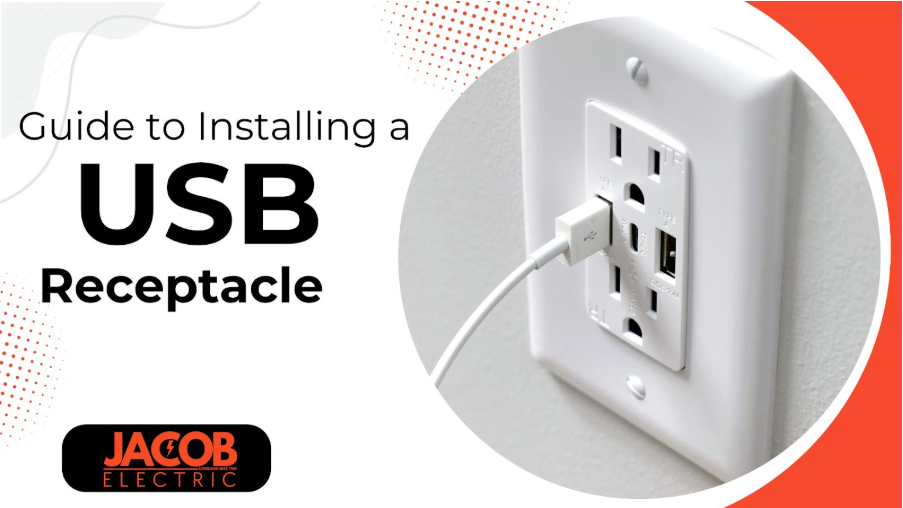You’ve likely experienced the frustration of your phone battery nearing single digits, only to find that charging blocks are nowhere to be found. Installing a few USB outlets in your home can eliminate the need to search for adapters and free up regular outlets for other uses. Keep reading to discover how USB outlets work, their advantages, installation tips, and when to call Jacob Electric LLC for professional help.
What is a USB Outlet?
A USB outlet looks like a typical electrical socket, but it includes built-in USB ports alongside standard power outlets. This allows you to plug a USB cable directly into the wall, bypassing the need for an adapter. This means your device charges directly from the electrical circuit.
Advantages of USB Outlets
USB outlets offer a range of benefits, including:
- Convenience: Charge your devices without needing adapters, and power multiple devices from a single outlet.
- Versatility: Support various devices by including different port types.
- Faster Charging: Many USB outlets support fast charging, speeding up the process compared to standard outlets.
- Sleek Design: Modernize your space with USB outlets that reduce clutter from bulky charging blocks.
Choosing the Right USB Outlet
Just like USB cables, USB outlets come in various types to accommodate different devices. The most common types include:
- USB-A: The standard port used by many devices, including chargers and computers.
- USB Micro-B: Common for older phones and cameras.
- USB-C: A versatile, fast-charging connector that’s quickly becoming the industry standard.
USB outlets come in various configurations:
- Standard USB outlet: Includes one or more USB-A ports along with regular electrical sockets.
- Combination USB outlet: Offers multiple port types, such as USB-A and USB-C, for flexible charging.
- Power Delivery (PD): Delivers higher wattage for faster charging, especially for larger devices, while dynamically adjusting to prevent overheating.
- Smart outlets: Feature integrated technology to control or automate devices remotely.
- Tamper-resistant outlets: Designed with safety features to prevent foreign objects from being inserted.
Safety Considerations
When installing or replacing an outlet with a USB socket, keep the following safety guidelines in mind:
- Choose a USB outlet that is UL-listed for safety.
- Don’t replace a GFCI (Ground Fault Circuit Interrupter) outlet with a USB outlet unless it’s part of a GFCI circuit or has GFCI protection.
- Ensure the wiring and circuit amperage are compatible with your new outlet, especially if it’s used for high-amperage appliances.
- Some local regulations may require upgrading to arc-fault protection when installing a new outlet—this may require a licensed electrician.
Ideal Locations for USB Outlets
Strategic placement of USB outlets can enhance convenience throughout your home. Consider installing them in these spots:
- Entertainment Centers: Create charging stations for remotes, gaming controllers, and other devices.
- Nightstands: Install USB outlets beside your bed for easy overnight charging of phones, tablets, and smartwatches.
- Home Offices: Keep USB outlets near your work area for hassle-free charging of laptops, phones, and other devices.
How to Install a USB Outlet
Installing a USB outlet is manageable for homeowners with basic electrical knowledge, but be sure to contact an electrician if you’re unsure about any steps. Follow these steps for a safe and effective installation:
Tools and Materials:
- Voltage tester
- Flathead screwdriver
- Needle-nose pliers
- Phillips screwdriver
- Wire stripper/cutter
- Electrical tape
- Outlet wall plate
- USB wall outlet
Installation Steps:
- Disconnect Power: Turn off the circuit breaker for the outlet you’re replacing. If you’re unsure which breaker controls the outlet, turn off the main power switch. Tape the switch to ensure it stays off during installation. Use a voltage tester to confirm the power is off.
- Remove the Existing Outlet: Use a flathead screwdriver to remove the cover plate. Unscrew the outlet from the wall using a Phillips head screwdriver.
- Take Note of Wiring: Draw a diagram, take a photo, or label the wires to remember how they are connected. Typically, the wires are color-coded as follows:
- White: Neutral wire, returns unused electricity.
- Black: Hot wire, delivers power.
- Copper/Green: Ground wire, provides safety by neutralizing electrical currents.
- Disconnect the Wires: Remove the screws or release clamps holding the wires, then use pliers to straighten them.
- Connect the Wires to the New USB Outlet: Follow the instructions on your new outlet to connect each wire to its appropriate terminal. Most outlets will have color-coded screws to help guide this. It’s recommended to connect the ground wire first to make positioning easier.
- Secure the Receptacle: Insert the USB outlet into the wall box and adjust the wires if necessary. Screw the outlet into place, ensuring it’s snug but not over-tightened. Attach the cover plate.
- Restore Power and Test: Turn the circuit breaker back on and use a voltage tester to confirm the outlet is working. Plug in a USB device to check that charging begins. Some outlets include an LED light to indicate active charging.
When to Call Jacob Electric LLC.
If you prefer a professional to install your USB outlets or encounter any difficulties, Jacob Electric LLC is here to help. Our licensed electricians can safely install USB outlets and handle other electrical tasks. Contact us today or schedule an appointment online for expert service.
Frequently Asked Questions
What should I do if my USB outlet stops working?
First, check if the circuit breaker has tripped and is switched on. If it’s equipped with GFCI, try resetting it. If you notice any damage such as cracks or scorch marks, call an electrician to inspect or replace the outlet.Can I install a USB outlet myself, or should I hire an electrician?
Installing a USB outlet is feasible for homeowners with basic electrical knowledge. If you’re unfamiliar with electrical work or if the installation requires additional steps like ensuring code compliance or repairing damaged wiring, it’s best to hire a licensed electrician.

